Pope Meets With President of Republic of Cyprus
Nicos Anastasiades
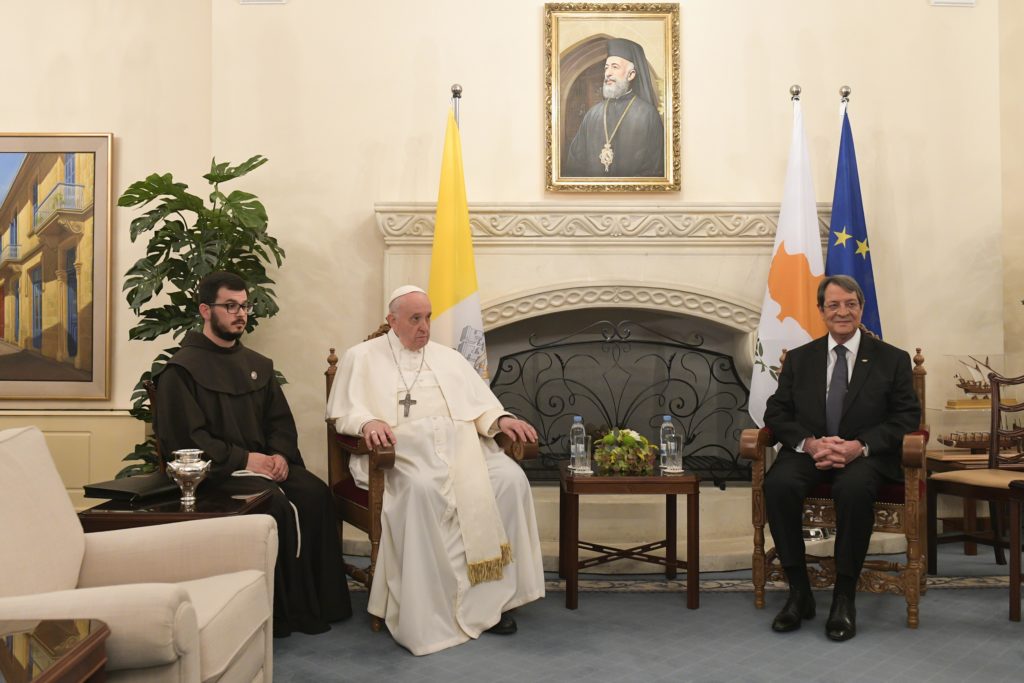
After meeting the priests, men and women religious, deacons, catechists, associations, and ecclesial movements of Cyprus at the Maronite Cathedral of Our Lady of Graces in Nicosia, Pope Francis drove to the Presidential Palace in the capital, where was received by the President of the Republic of Cyprus, Nicos Anastasiades, outside the Palace, near the statue of Archbishop Makarios.
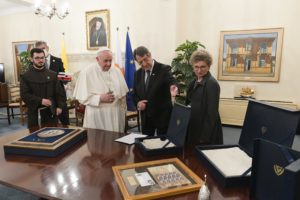 After the guard of honor and the interpretation of the hymns, and after the placement of a wreath before the statue of Makarios, the presentation of the respective delegations took place. The President of the Republic accompanied the Holy Father to the entrance of the Palace where they posed for the official photo. Afterward, they went to the president’s office, where the courtesy visit took place at 5.30 p.m.
After the guard of honor and the interpretation of the hymns, and after the placement of a wreath before the statue of Makarios, the presentation of the respective delegations took place. The President of the Republic accompanied the Holy Father to the entrance of the Palace where they posed for the official photo. Afterward, they went to the president’s office, where the courtesy visit took place at 5.30 p.m.
After the private meeting, the exchange of gifts and the presentation of the family took place. Finally, the President of the Republic and the Pope have gone to the Ceremony Room to meet with the authorities.
Gift of the Holy Father to the President
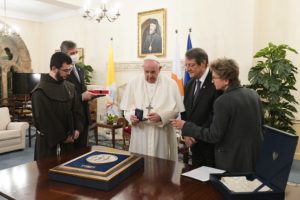 The commemorative medal of the Apostolic Journey of Pope Francis to Cyprus and Greece presents the two apostles Paul and Barnabas, fundamental figures in the evangelization of these lands. Saint Barnabas is on the left, with the Gospel in one hand and a crozier in the other, symbols of his pilgrimage to announce the Word. We can recognize the Chrysopolitissa church of Paphos, which symbolically expresses the long history of Christianity in Cyprus and which, in addition, is today a meeting place for the different Christian denominations. On the right is the apostle Paul, with a pen and a scroll, writing his famous epistles. Behind him is a symbolic view of ancient Greece, which was Greece, that the apostle Paul toured and evangelized; their meeting at the Areopagus in Athens is famous in this sense.
The commemorative medal of the Apostolic Journey of Pope Francis to Cyprus and Greece presents the two apostles Paul and Barnabas, fundamental figures in the evangelization of these lands. Saint Barnabas is on the left, with the Gospel in one hand and a crozier in the other, symbols of his pilgrimage to announce the Word. We can recognize the Chrysopolitissa church of Paphos, which symbolically expresses the long history of Christianity in Cyprus and which, in addition, is today a meeting place for the different Christian denominations. On the right is the apostle Paul, with a pen and a scroll, writing his famous epistles. Behind him is a symbolic view of ancient Greece, which was Greece, that the apostle Paul toured and evangelized; their meeting at the Areopagus in Athens is famous in this sense.
Nicos Anastasiades
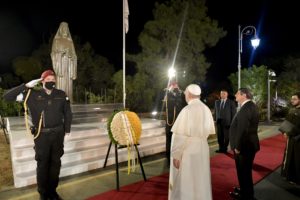 The President of the Republic of Cyprus, Nicos Anastasiades, was born in Pera Pedi, Limassol, in 1946. He received a law degree from the University of Athens in 1969 and a degree in Navigation Law from University College London in 1971. Since 1972 he has practiced as a lawyer. In 1976 he was one of the founding members of the center-right party Agrupación Democrática (DISY), of which he was vice president (1995-97) and president in 1997, reelected in 1999, 2003, and 2006.
The President of the Republic of Cyprus, Nicos Anastasiades, was born in Pera Pedi, Limassol, in 1946. He received a law degree from the University of Athens in 1969 and a degree in Navigation Law from University College London in 1971. Since 1972 he has practiced as a lawyer. In 1976 he was one of the founding members of the center-right party Agrupación Democrática (DISY), of which he was vice president (1995-97) and president in 1997, reelected in 1999, 2003, and 2006.
From 1981 until his election as President of the Republic, he was a member of the House of Representatives. During his long tenure, he held various positions in Parliament: among others, he was Chairman of the Foreign Affairs Committee, Chairman of the Education Committee, and Chairman of the Inter-Parliamentary Foreign Affairs Committee. He was appointed Vice President of the House of Representatives from 1996 to 2001. On February 24, 2013, he was elected President of the Republic of Cyprus, winning the second round with a majority of 57.4%. Anastasiades is married and has two daughters.
Presidential palace
The Presidential Palace (Greek: Προεδρικό Μέγαρο, Proedrikó Mégaro; Turkish: Cumhurbaşkanlığı Sarayı) is the official residence and main workplace of the President of the Republic of Cyprus. It is located near the city center and is surrounded by a dense pine forest.
Built-in the 1930s, the palace replaced an earlier wooden building that burned down during a Greek Cypriot demonstration. It was also partially destroyed during the Greek military junta coup on July 15, 1974, and later painstakingly restored. The Presidential Palace was the former Government House, the residence of the Governor when Cyprus was under British rule (1878-1960). The structure, which still bears the British coat of arms, is characterized by its Byzantine, Gothic and Turkish elements. On the south side, there are four gargoyles, four gargoyles with human heads representing the British master builder in charge of the construction, the chief bricklayer, the chief carpenter, and an unknown worker.
For the construction of the Government House, wood was used from the Cypriot forests (eucalyptus, pine, banana, cypress, walnut) and from other areas of the British Empire, such as Burma and Canada. Following the independence of Cyprus and the departure of the British Governor in 1960, the building became the official Presidential Palace of the Republic of Cyprus.
Related
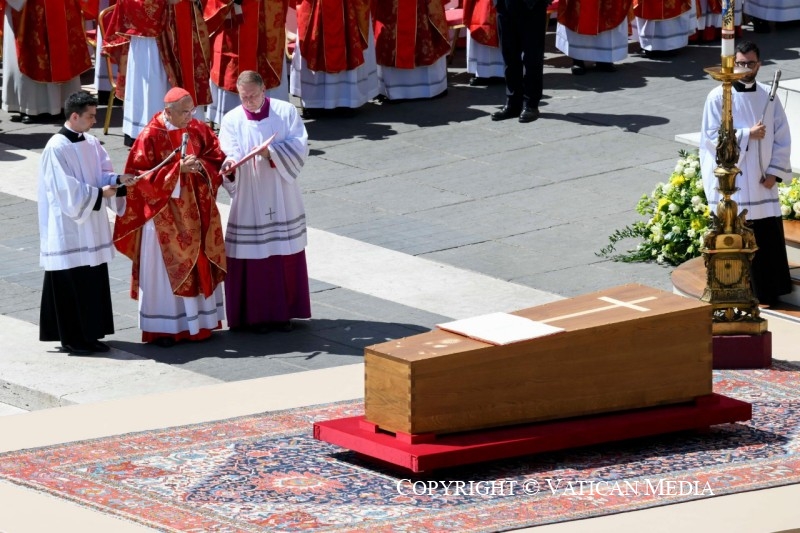
Mercy and the joy of the Gospel are two key concepts of Pope Francis
Exaudi Staff
26 April, 2025
9 min

Thousands of faithful bid farewell to Pope Francis in St. Peter’s Square
Exaudi Staff
26 April, 2025
2 min
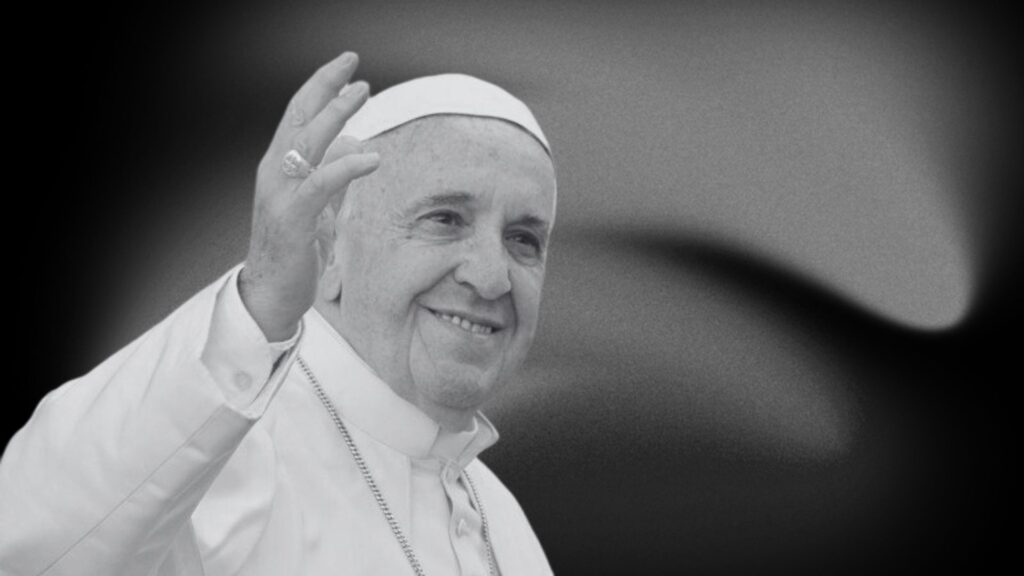
Saying Goodbye to Francis
Exaudi Staff
26 April, 2025
2 min
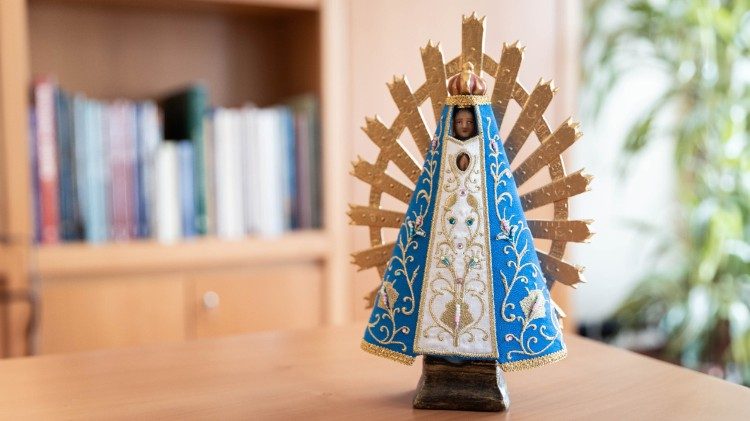
Pope Francis Gifts a Statue of Our Lady of Luján to Gemelli and the Catholic University of the Sacred Heart
Exaudi Staff
25 April, 2025
2 min
 (EN)
(EN)
 (ES)
(ES)
 (IT)
(IT)

